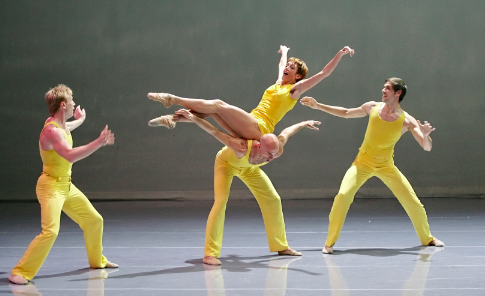A chic crowd gathered at the Joyce Theater last Wednesday -- thin women in fat furs, chattering in French. It was the opening night of Les Ballets de Monte Carlo, and some of Monaco's legendary glamor seemed to have made its way across the ocean with the company.
Monaco: A place once home to the Ballets Russes, a place that boasts a real royal family. One of those royals -- Princess Caroline -- is Les Ballets' principal patron. And what a difference a princess makes. The evening's opening work was costumed by none other than Karl Lagerfeld; the second piece featured a cast of nearly 30. ("That," said a man next to me, "is a lot of per diems.")
Les Ballets is a contemporary ballet company, but its dancers are beautiful classicists, especially the women. Their pointework--a skill often neglected in contemporary troupes--is crisp and articulate, the undergirding strength of their technique evident. The company's star, Bernice Coppieters, is an elegant wonder, the kind of ballerina who appears to be wearing a tiara even when clad in Lagerfeld's (sigh) gold leather pants.
But the program's choreography -- all of it by artistic director Jean-Christophe Maillot -- didn't show us the full range of their powers. You'd think that a ballet set to Claudio Monteverdi's solemn cathedral music (Altro Canto Part I) would have to be utterly unlike one set to Meredith Monk's wacky caterwauling (Opus 40). And yet both were similarly textured. I think of Maillot's style as "noodly": fluid limbs, few moments of stillness. It must feel good to dance, and it makes the dancers look good, too, giving them a little wiggle room (literally) to camouflage any mistakes. But from the audience it seems mushy. The choreography's images melt in your hand, not in your mouth. After a while, you struggle to remember what happened five minutes ago, one minute ago, 10 seconds ago.
Altro Canto's original set, an arch of candles, didn't make it to the Joyce. (American fire regulations, I'm guessing, are stricter than Monégasque ones.) But the flame motif was still apparent, with the dancers themselves shimmering and sputtering through a series of fraught duets and trios. One dancer even "extinguished" another's flickering hand by blowing on it. Before long a Jesus figure (Coppieters) arrived -- or, rather, a Jesus/siren figure, sent to seduce as well as bless. A group of men lined up as if to receive communion; instead, each received the tip of Coppieters' pointe shoe in his hands. I think it was all meant to be very provocative. Instead it made me feel only vaguely squirmy, more uncomfortable with Maillot's self-consciousness than with whatever subversion he was aiming for.

Les Ballets de Monte Carlo in Opus 40. Photo by Marie-Laure Briane.
Self-consciousness sullied Opus 40, too -- and too bad, because however thorny Meredith Monk's songs can be, they're always pure, innocent, true to themselves. That's probably why they inspired Maillot to create an "ode to Youth," as the program notes say. But while a blithe, free-associative opening solo for Coppieters was in keeping that idea, the rest of the ballet felt stiff and posturey. Maillot asked his dancers to take their child's play very seriously--and that made it hard for us to do so.
A former dancer and choreographer, Margaret Fuhrer is an associate editor at Dance Spirit and Pointe magazines and a contributing editor at Dance Teacher magazine.